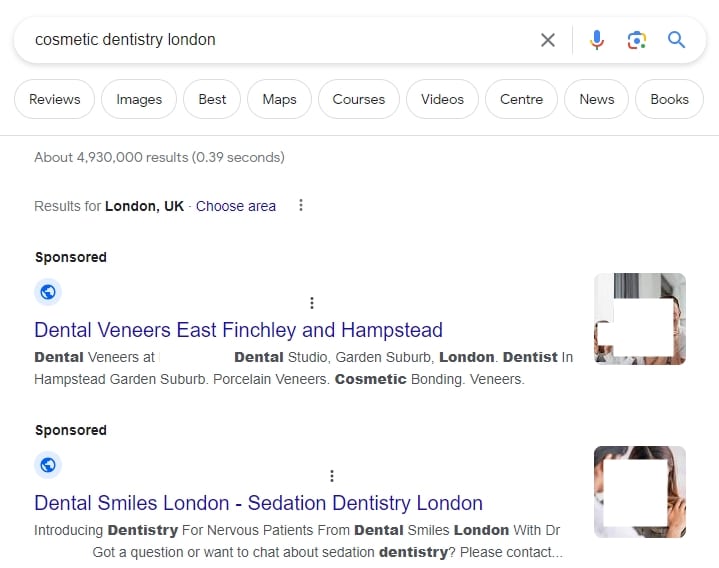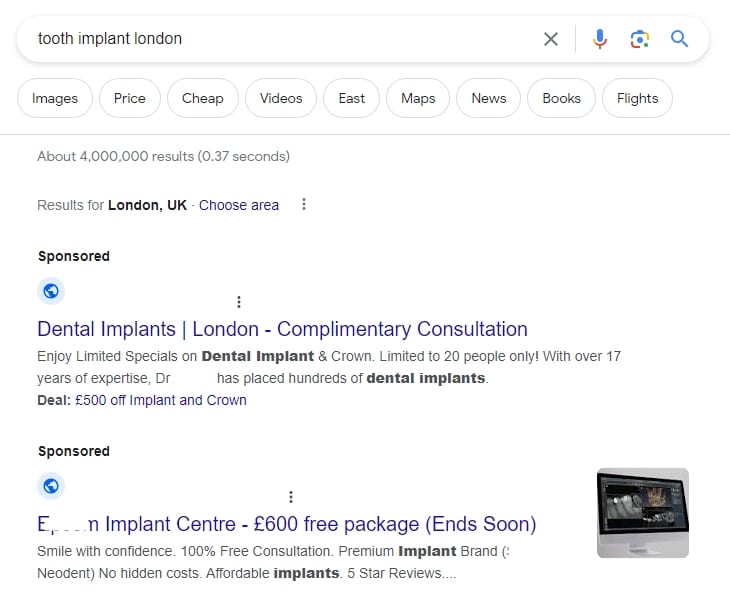How To Set Up Google Ads for Dentists

Last Updated on: 30th May 2025, 01:56 pm
You can’t reach everyone who needs dental services by relying on referrals. Instead, you need to intercept them when they’re looking for a dentist, and there’s no better way to do it than with Google Ads for dentists.
In this guide, I’ll walk you through the ins and outs of creating successful ad campaigns that increase bookings. With over 15 years of experience in running Google Ads for dentists, I’ve been through it all, and I’m here to show you how to get more returns for every dollar (or penny) you spend.
Ready? Let’s take a look!
Why Should You Consider Google Ads for Your Dental Practice?
Firstly, Google Ads (previously known as Google AdWords) allows you to reach a highly targeted audience. With Google’s advanced targeting options, you can show your ads to people actively searching for dental services in your area.
Your ads will be seen by the right people at the right time, increasing the likelihood of getting a call – as opposed to sharing your business card and hoping someone finds it just when they’ve developed a toothache.
Secondly, Google Ads provides measurable results. Unlike radio, TV, or word-of-mouth advertising, you’ll be able to track the performance of your Google Ads campaigns in real time. You’ll see how many clicks your ads receive, how many conversions they generate, and how much you spend on each click.
You’ll be able to identify your most profitable customers, focus on the keywords driving them to book a consultation and make the most of your budget.
As I always tell my Google Ads clients – avoid casting a broad net. Instead, pinpoint the most profitable customers. And Google Ads has some phenomenal ways of doing it!
Another benefit of using Google Ads for dentists is retaining complete control over your budget. You can set a daily spending limit that suits your needs, adjust your bids based on the ad performance, and tweak the ad settings so you’re getting the highest visibility possible.
All in all, I’ve found Google Ads to be one of the most effective advertising platforms, especially when you consider how quickly it’s adding new features. I’ve used it to profitably advertise my clients’ businesses, as well as my own. Everyone is on Google, so that’s where your practice should be, too.
Which Google Ads Campaigns Should You Run as a Dentist?
If you’re new to Google Ads and want to do it on your own, I recommend search campaigns.
Search campaigns are a tried and true method for reaching people while they’re actively searching for dentists. All you have to do is identify the right keywords and create an excellent ad showing why they should choose you.
(Easier said than done? I know! That’s why I share my best practices for ad copy, landing pages, and increasing your Quality Score.)

Secondly, you could try display campaigns. They’ll show your ads on websites, apps, and YouTube. Now, these are more finicky, and the targeting isn’t as precise, but they work wonders for remarketing ads when someone visits your website but doesn’t convert.
Of course, there are plenty of other types of Google Ads campaigns, so click the link to discover them all. But as an experienced Google Ads manager, I recommend starting with a search campaign.
How to Do Keyword Research for Dental Google Ads Campaigns
Keyword research is crucial for planning and creating successful dental Google Ads campaigns.
First, start with broad keywords describing your dental services (e.g., “dentist,” “dental clinic,” “teeth whitening”). Then, narrow them down through keyword research to find the keywords you should target (e.g., “cosmetic dentist for veneers,” “dental implant specialist,” etc.).
The more specific your keywords are, the better. If you optimise your campaigns for those keywords, you’ll be able to attract highly motivated leads instead of searchers just looking for information (and not to schedule a consultation).
Consider your customers’ keyword journey:
- How do they start researching for information?
- What do they search for when they’re ready to consult a dentist?
- Which keywords do they use when they need emergency services?
Use tools like SpyFu to see which keywords your competitors are targeting with their campaigns:
- Are there any gaps between theirs and your strategy that you can exploit?
- Do they use any particularly profitable keywords?
Once you have a list of relevant keywords, group them into ad groups based on their similarity. You always want to have dedicated ads for specific keywords.
For example, you wouldn’t want to target prospects for “teeth whitening” and “dental implants” with the same ad. The ad won’t be highly relevant to any of those two groups, decreasing your Quality Score and increasing your Cost Per Click.
In contrast, an ad tailored specifically to “dental implants” allows you to address that audience’s concerns: Does the procedure hurt? What are the implants made of? What does recovery look like?

How to Create Effective Ad Copy for Dental Google AdWords
Firstly, highlight your unique selling proposition: What sets your dental practice apart from your competitors? Is it your experience, state-of-the-art technology, or personalised approach?
Your competitors run Google Ads, too, so it’s crucial that you stand out from the masses. Look at what your competitors are currently highlighting and see if it’s a viable value proposition you can tweak – or if you can write something that speaks to your audience even more.
Secondly, incorporate your target keywords into your ad copy to make it more relevant to the user’s search query. This can improve your ad’s Quality Score and increase its chances of being shown prominently and at a lower CPC.
Instead of simply listing your services, focus on the benefits that potential patients will experience by choosing your dental practice. For example:
- “Achieve a bright and confident smile.”
- “Experience pain-free dental treatments.”
Don’t forget to include a strong call to action. For example, “Call now for a free consultation” or “Book an appointment online.”
Finally, make sure your landing page reflects what you promised in the ad copy. Ideally, you should create dedicated landing pages for each campaign.
Measuring Performance
Set up conversion tracking for your dentist Google Ads as soon as possible. Follow my step-by-step guide here.
Conversion tracking allows you to monitor the actual ad conversions so you create more ads like the ones sending you a lot of customers and eliminate the ineffective ones. This will also allow you to use advanced bidding methods like the Maximise conversions bid strategy.
Additionally, keep a close eye on the performance of your campaigns. Regularly review key metrics such as:
- Click-through rates
- Conversion rates
- Cost per conversion
Then, identify underperforming keywords, ads, and campaigns and make adjustments as needed. You might need to strengthen your negative keywords list, test different ad copy and landing page variants, adjust your bids, add ad extensions, and more.
All of this will come naturally to you – or, if you want to scale faster, get in touch with me for a personalised consult.
Google Ads for Dentists: A Cost-Effective Way to Grow Your Practice
In conclusion, Google Ads for dentists isn’t just a cost-effective option; it’s your ticket to scaling your dental practice.
Grow your practice, one Google Ads click at a time!
Ready to get started? Download your copy of my best-selling Google Ads book. You’ll learn how to create a successful campaign and get more high-quality clients in 7 rapid steps.







